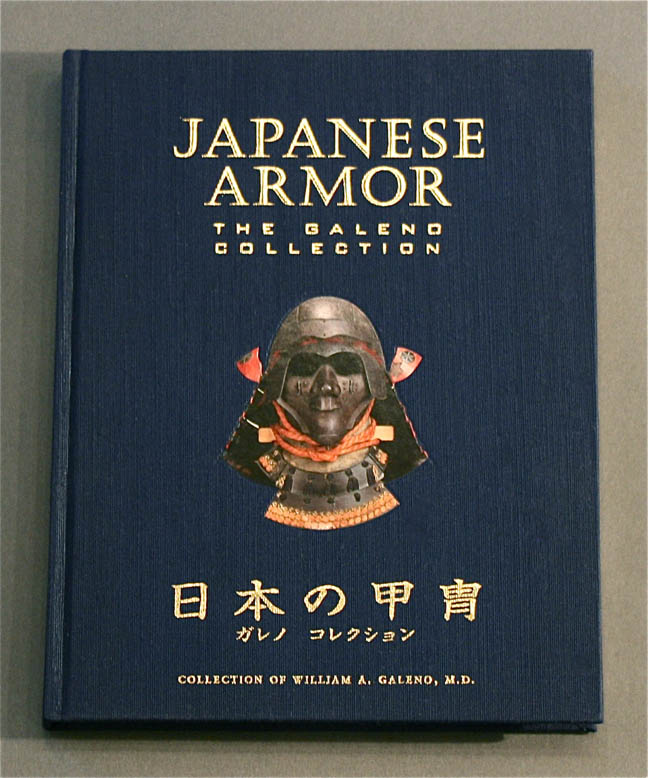

Title: Illustrated Book of Japanese Armor From The Galeno Collection
Shipping: $20.00
Artist: N/A
Period: Contemporary
History: N/A
Origin: Central Asia > Japan
Condition: Museum Quality
Item Date: 1998
Item ID: 4241
The great collection of Japanese armor, William A. Galeno, M.D. text by Ian Bottomley. This book is hand sign by Dr Galeno. Richly illustrated, this book presents Japanese armor from the collection of William A. Galeno, M.D., one of the largest private collections of Japanese armor in the West. It includes more than 100 pieces of armor, helmets, masks and accoutrements - almost all of which are made available to the public for the first time - spanning from the 14th century of the Muromachi period to the 19th century of the Edo period. With catalog entries and essays on the history of Japanese armor by Ian Bottomley, Curator of Oriental Arms and Armour at Her Majesty's Royal Armoury, Leeds, England, this catalog is a valuable reference for scholars, collectors and readers interested in the subject.
Link: http://en.wikipedia.org/wiki/Japanese_armor
Japanese armour has developed enormously over the centuries since its introduction to the battlefield. It was worn to varying degrees by numerous classes; most notably by the Samurai (and by default the ashigaru), and was seen on the battlefield both on mounted and foot troops. The pinnacle of Japanese lamellar armour is generally accepted as being the O-Yoroi (大鎧) (literally 'great armour') type.
Japanese armour evolved from the equipment in use in mainland ancient China. Early armour was made of bronze and included a cuirass and tall helmet designed to deflect blows from a sword. At first this was a simple design but with the introduction of tempered steel swords this evolved into a helmet resembling the 20th-century Stahlhelm.
In the 16th century Japan began trading with Europe during what would become known as the Nanban trade. Samurai acquired European armour including the cuirass and comb morion which they modified and combined with domestic armour as it provided better protection from the newly-introduced matchlock muskets.
Armour was worn during the Tokugawa Shogunate even after guns had replaced the naginata and bow, and was still in use by rebel samurai during the Boshin War and Meiji Restoration.
Japanese armour was generally made of many small steel or leather plates connected to each other by rivets, lace, or chain armour kusari. These armor plates could be attached to a leather or cloth backing. It was designed to be as lightweight as possible as the samurai had many tasks including riding a horse and archery in addition to swordsmanship. It was often brightly painted. Silk clothing was worn under the armour as protection from arrows, trapping the barbs and making it easier for the samurai to pull it out. A full suit of traditional Samurai armour could include the following items:
• A skirted breastplate dō or dou made up of iron and or leather plates of various sizes and shapes with pendents kusazuri made from iron or leather plates hanging from the front and back of the dō or dou to protect the lower body and upper leg.
• Large rectangular shoulder protection sode made from iron and or leather plates.
• Armoured gloves kote which extended to the shoulder or kote gauntlets which covered the forearms. Kote were made from cloth covered with iron plates of various size and shape, connected by chain armor kusari, to protect the hands and arms from an enemy's sword.
• A helmet called a kabuto made from iron or leather plates ( from 3 to over 100 plates) riveted together. A neck guard shikoro made from several layers of curved iron or leather strips was suspended from the bottom edge of the kabuto.
• A lacquered metal mask called a Menpō designed to tie and secure the top heavy helmet kabuto to. The Menpō had a throat guard yodare-kake made from several layers of iron or leather stripes suspended from the bottom edge.
• Thigh guards haidate which tied around the waist and covered the thighs. These were made from cloth with small iron and or leather plates of various size and shape, usually connected to each other by chain armour kusari and sewn to the cloth.
• Shin guards suneate made from iron splints connected together by chain armor kusari and sewn to cloth and tied around the calf.
• A sash called an obi for carrying the katana, wakizashi and tantō
• Tight leggings worn over baggy pants called hakama
• Woven sandals known as zōri or waraji worn with socks called tabi, or kutsu - short riding boots made from leather and trimmed with bear fur, or tsuranuki - ancient long riding boots from bear's skin. or kogake armored tabi, a kind of sabaton.